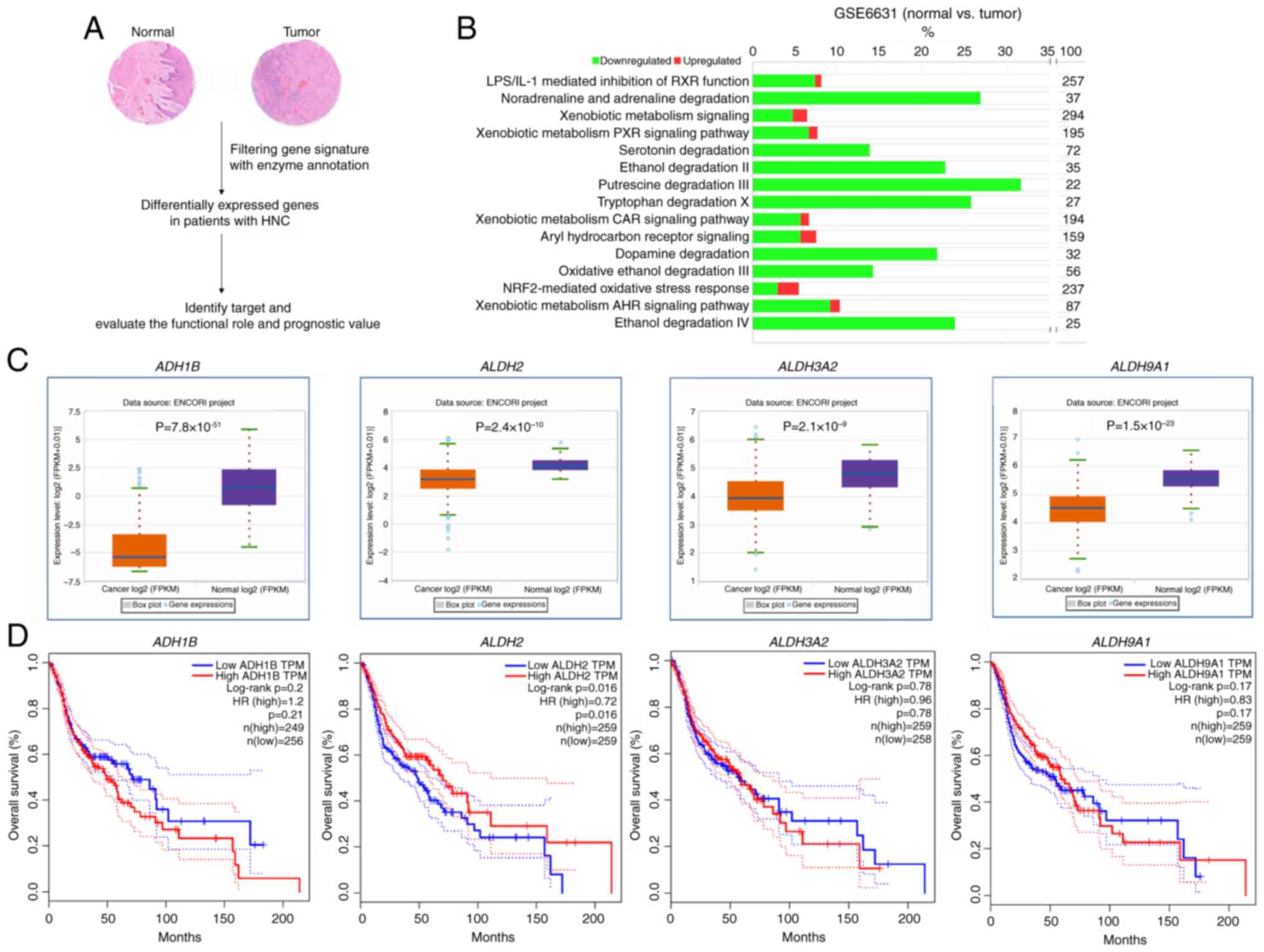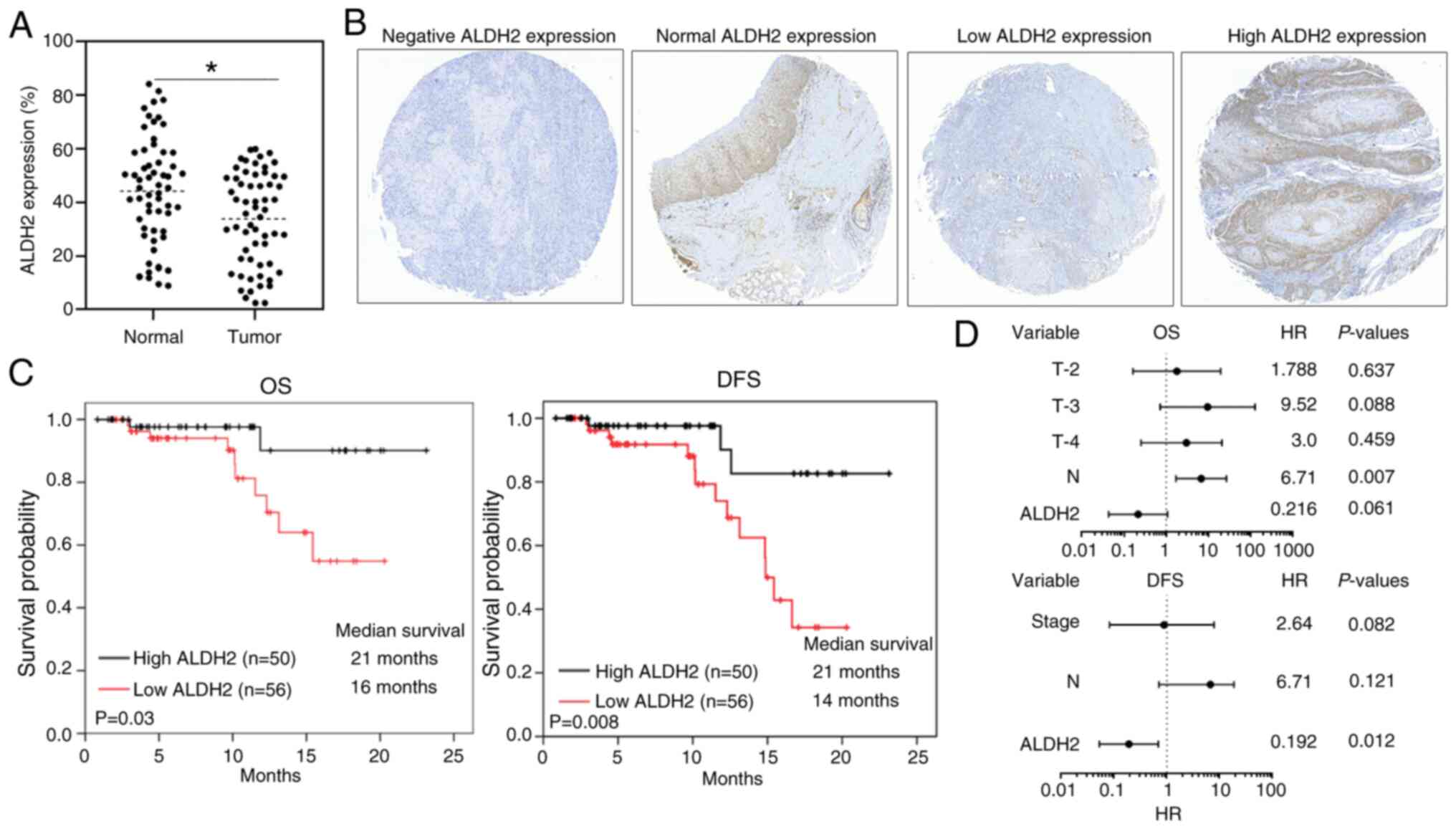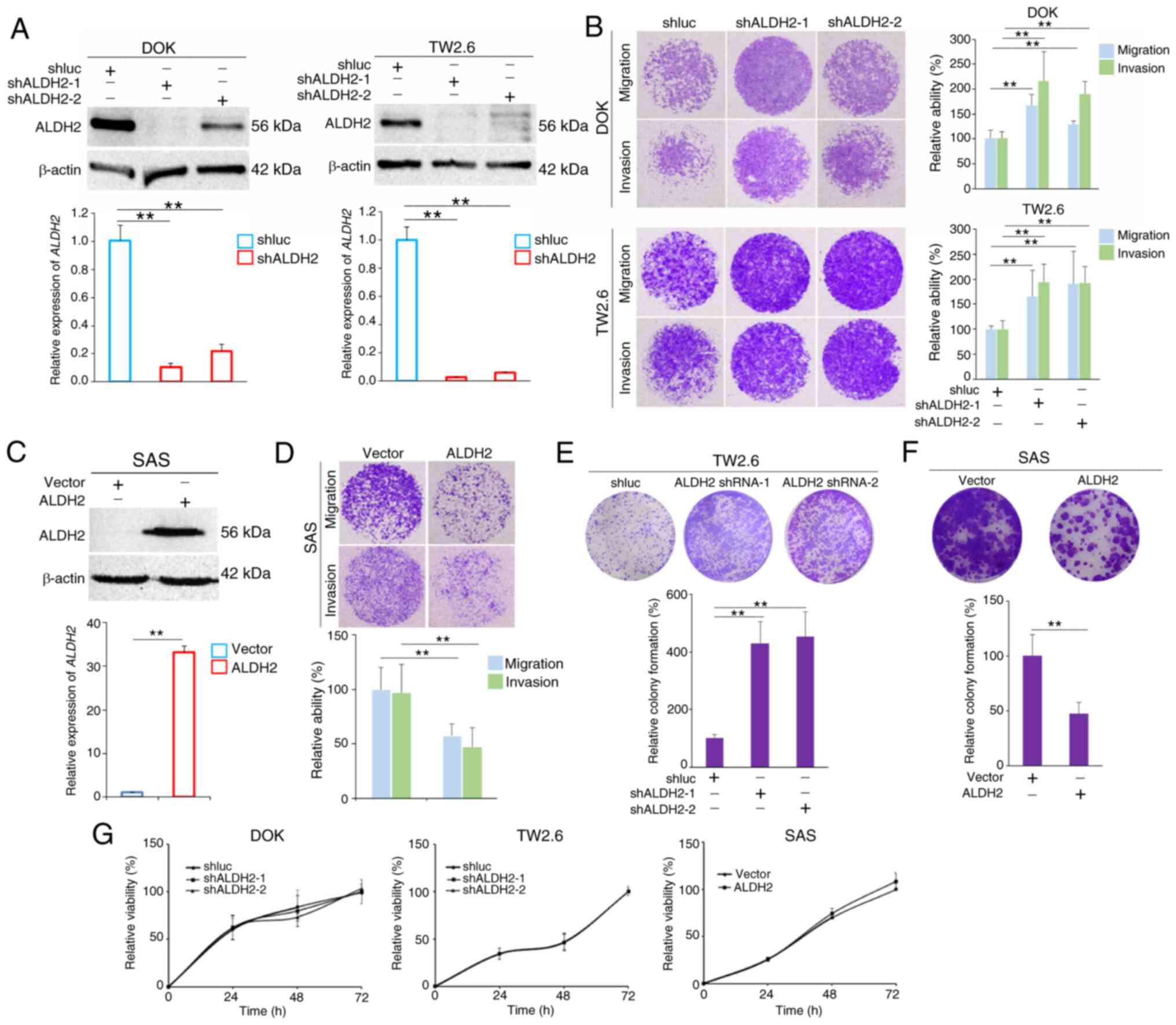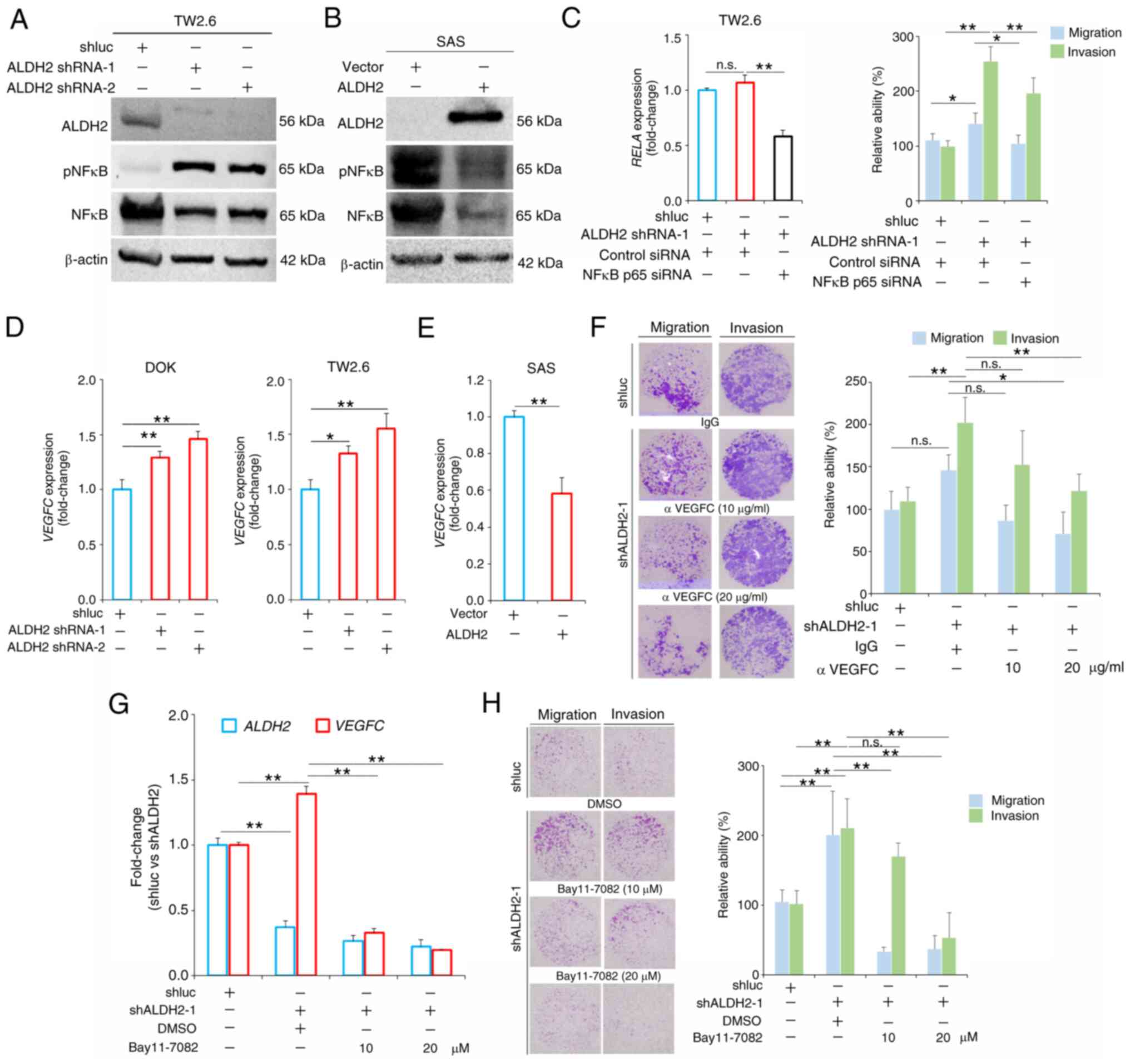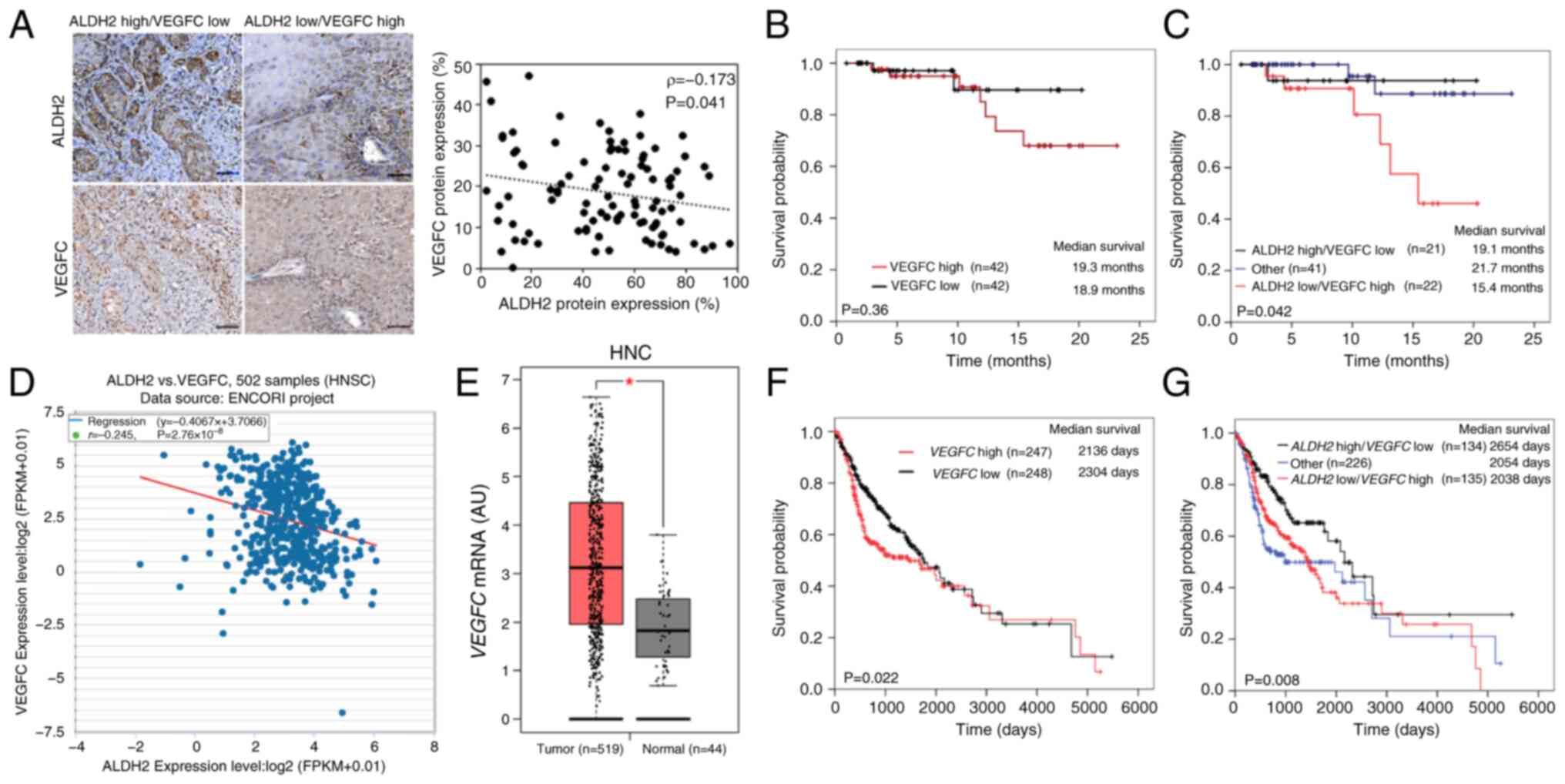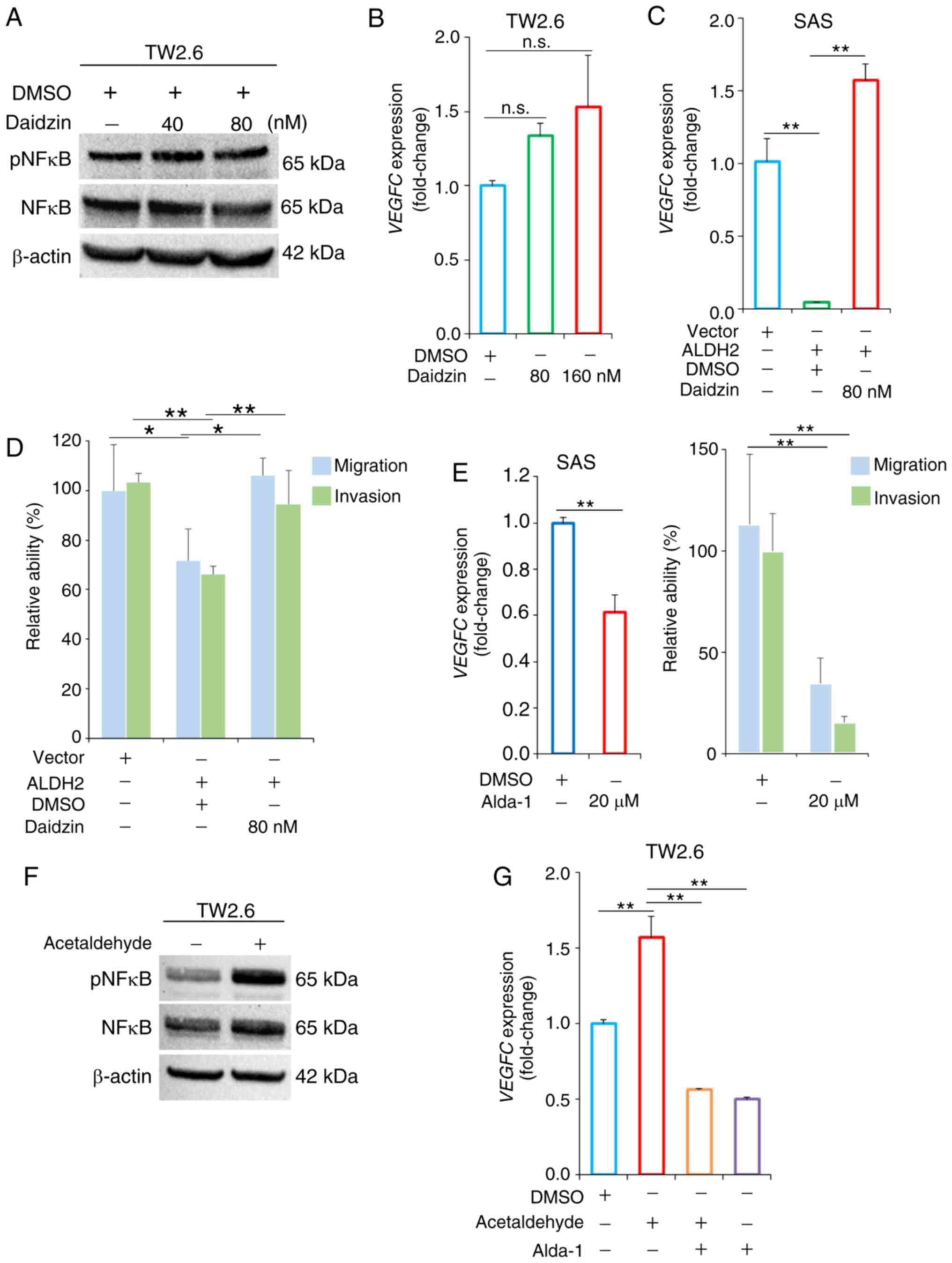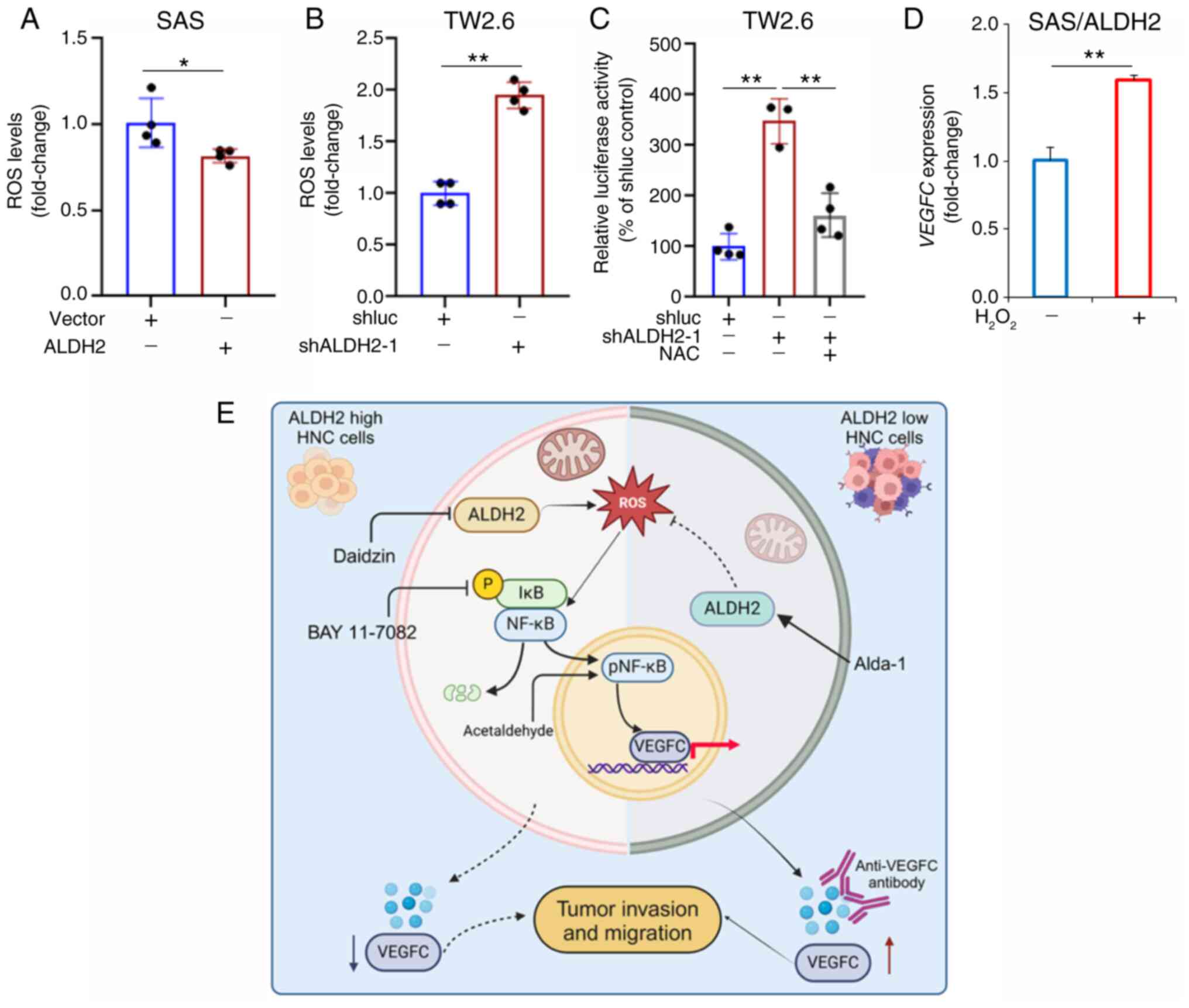|
1
|
Sung H, Ferlay J, Siegel RL, Laversanne M,
Soerjomataram I, Jemal A and Bray F: Global cancer statistics 2020:
GLOBOCAN estimates of incidence and mortality worldwide for 36
cancers in 185 countries. CA Cancer J Clin. 71:209–249. 2021.
View Article : Google Scholar : PubMed/NCBI
|
|
2
|
Johnson DE, Burtness B, Leemans CR, Lui
VWY, Bauman JE and Grandis JR: Head and neck squamous cell
carcinoma. Nat Rev Dis Primers. 6:922020. View Article : Google Scholar : PubMed/NCBI
|
|
3
|
Cancer Genome Atlas Network: Comprehensive
genomic characterization of head and neck squamous cell carcinomas.
Nature. 517:576–582. 2015. View Article : Google Scholar : PubMed/NCBI
|
|
4
|
Faubert B, Solmonson A and DeBerardinis
RJ: Metabolic reprogramming and cancer progression. Science.
368:eaaw54732020. View Article : Google Scholar : PubMed/NCBI
|
|
5
|
Xia L, Oyang L, Lin J, Tan S, Han Y, Wu N,
Yi P, Tang L, Pan Q, Rao S, et al: The cancer metabolic
reprogramming and immune response. Mol Cancer. 20:282021.
View Article : Google Scholar : PubMed/NCBI
|
|
6
|
Chen CH, Ferreira JC, Gross ER and
Mochly-Rosen D: Targeting aldehyde dehydrogenase 2: New therapeutic
opportunities. Physiol Rev. 94:1–34. 2014. View Article : Google Scholar : PubMed/NCBI
|
|
7
|
Gao J, Hao Y, Piao X and Gu X: Aldehyde
dehydrogenase 2 as a therapeutic target in oxidative stress-related
diseases: Post-translational modifications deserve more attention.
Int J Mol Sci. 23:26822022. View Article : Google Scholar : PubMed/NCBI
|
|
8
|
Chen D, Fang L, Li H and Jin C: The
effects of acetaldehyde exposure on histone modifications and
chromatin structure in human lung bronchial epithelial cells.
Environ Mol Mutagen. 59:375–385. 2018. View Article : Google Scholar : PubMed/NCBI
|
|
9
|
Lee WT, Hsiao JR, Ou CY, Huang CC, Chang
CC, Tsai ST, Chen KC, Huang JS, Wong TY, Lai YH, et al: The
influence of prediagnosis alcohol consumption and the polymorphisms
of ethanol-metabolizing genes on the survival of head and neck
cancer patients. Cancer Epidemiol Biomarkers Prev. 28:248–257.
2019. View Article : Google Scholar
|
|
10
|
Tang Z, Li C, Kang B, Gao G, Li C and
Zhang Z: GEPIA: A web server for cancer and normal gene expression
profiling and interactive analyses. Nucleic Acids Res. 45(W1):
W98–W102. 2017. View Article : Google Scholar : PubMed/NCBI
|
|
11
|
Edge SB and Compton CC: The American joint
committee on cancer: The 7th edition of the AJCC cancer staging
manual and the future of TNM. Ann Surg Oncol. 17:1471–1474. 2010.
View Article : Google Scholar : PubMed/NCBI
|
|
12
|
Tseng HH, Tseng YK, You JJ, Kang BH, Wang
TH, Yang CM, Chen HC, Liou HH, Liu PF, Ger LP and Tsai KW:
Next-generation sequencing for microRNA profiling: MicroRNA-21-3p
promotes oral cancer metastasis. Anticancer Res. 37:1059–1066.
2017. View Article : Google Scholar : PubMed/NCBI
|
|
13
|
Liu CW, Hua KT, Li KC, Kao HF, Hong RL, Ko
JY, Hsiao M, Kuo ML and Tan CT: Histone Methyltransferase G9a
drives chemotherapy resistance by regulating the glutamate-cysteine
ligase catalytic subunit in head and neck squamous cell carcinoma.
Mol Cancer Ther. 16:1421–1434. 2017. View Article : Google Scholar : PubMed/NCBI
|
|
14
|
Livak KJ and Schmittgen TD: Analysis of
relative gene expression data using real-time quantitative PCR and
the 2(-Delta Delta C(T)) method. Methods. 25:402–408. 2001.
View Article : Google Scholar
|
|
15
|
Chang SE, Foster S, Betts D and Marnock
WE: DOK, a cell line established from human dysplastic oral mucosa,
shows a partially transformed non-malignant phenotype. Int J
Cancer. 52:896–902. 1992. View Article : Google Scholar : PubMed/NCBI
|
|
16
|
Bs A, P A, As SG, A P and J VP: Analysis
of differentially expressed genes in dysplastic oral keratinocyte
cell line and their role in the development of HNSCC. J Stomatol
Oral Maxillofac Surg. 125:1019282024. View Article : Google Scholar : PubMed/NCBI
|
|
17
|
Chen YF, Chang KW, Yang IT, Tu HF and Lin
SC: Establishment of syngeneic murine model for oral cancer
therapy. Oral Oncol. 95:194–201. 2019. View Article : Google Scholar : PubMed/NCBI
|
|
18
|
Lin C, Song L, Gong H, Liu A, Lin X, Wu J,
Li M and Li J: Editor's Note: Nkx2-8 downregulation promotes
angiogenesis and activates NF-κB in esophageal cancer. Cancer Res.
82:16702022. View Article : Google Scholar
|
|
19
|
Strickson S, Campbell DG, Emmerich CH,
Knebel A, Plater L, Ritorto MS, Shpiro N and Cohen P: The
anti-inflammatory drug BAY 11-7082 suppresses the MyD88-dependent
signalling network by targeting the ubiquitin system. Biochem J.
451:427–437. 2013. View Article : Google Scholar : PubMed/NCBI
|
|
20
|
Chen Y, Sun J, Liu J, Wei Y, Wang X, Fang
H, Du H, Huang J, Li Q, Ren G, et al: Aldehyde dehydrogenase
2-mediated aldehyde metabolism promotes tumor immune evasion by
regulating the NOD/VISTA axis. J Immunother Cancer. 11:e0074872023.
View Article : Google Scholar : PubMed/NCBI
|
|
21
|
Lachenmeier DW and Sohnius EM: The role of
acetaldehyde outside ethanol metabolism in the carcinogenicity of
alcoholic beverages: Evidence from a large chemical survey. Food
Chem Toxicol. 46:2903–2911. 2008. View Article : Google Scholar : PubMed/NCBI
|
|
22
|
Li SY, Gomelsky M, Duan J, Zhang Z,
Gomelsky L, Zhang X, Epstein PN and Ren J: Overexpression of
aldehyde dehydrogenase-2 (ALDH2) transgene prevents
acetaldehyde-induced cell injury in human umbilical vein
endothelial cells: Role of ERK and p38 mitogen-activated protein
kinase. J Biol Chem. 279:11244–11252. 2004. View Article : Google Scholar : PubMed/NCBI
|
|
23
|
Morgan MJ and Liu ZG: Crosstalk of
reactive oxygen species and NF-kappaB signaling. Cell Res.
21:103–115. 2011. View Article : Google Scholar
|
|
24
|
Lin YH, Yang YF, Liao JB, Chang TS,
Janesha UGS and Shiue YL: Analysis of aldehyde dehydrogenase 2 as a
prognostic marker associated with immune cell infiltration and
chemotherapy efficacy in head and neck squamous cell carcinoma. J
Cancer. 14:1689–1706. 2023. View Article : Google Scholar : PubMed/NCBI
|
|
25
|
Garaycoechea JI, Crossan GP, Langevin F,
Mulderrig L, Louzada S, Yang F, Guilbaud G, Park N, Roerink S,
Nik-Zainal S, et al: Alcohol and endogenous aldehydes damage
chromosomes and mutate stem cells. Nature. 553:171–177. 2018.
View Article : Google Scholar : PubMed/NCBI
|
|
26
|
Li K, Guo W, Li Z, Wang Y, Sun B, Xu D,
Ling J, Song H, Liao Y, Wang T, et al: ALDH2 repression promotes
lung tumor progression via accumulated acetaldehyde and DNA damage.
Neoplasia. 21:602–614. 2019. View Article : Google Scholar : PubMed/NCBI
|
|
27
|
Dalleau S, Baradat M, Guéraud F and Huc L:
Cell death and diseases related to oxidative stress:
4-Hydroxynonenal (HNE) in the balance. Cell Death Differ.
20:1615–1630. 2013. View Article : Google Scholar : PubMed/NCBI
|
|
28
|
Zahn-Zabal M, Michel PA, Gateau A, Nikitin
F, Schaeffer M, Audot E, Gaudet P, Duek PD, Teixeira D, Rech de
Laval V, et al: The neXtProt knowledgebase in 2020: Data, tools and
usability improvements. Nucleic Acids Res. 48(D1): D328–D334.
2020.
|
|
29
|
Legler DF, Micheau O, Doucey MA, Tschopp J
and Bron C: Recruitment of TNF receptor 1 to lipid rafts is
essential for TNFalpha-mediated NF-kappaB activation. Immunity.
18:655–664. 2003. View Article : Google Scholar : PubMed/NCBI
|
|
30
|
Yang YF, Jan YH, Liu YP, Yang CJ, Su CY,
Chang YC, Lai TC, Chiou J, Tsai HY, Lu J, et al: Squalene synthase
induces tumor necrosis factor receptor 1 enrichment in lipid rafts
to promote lung cancer metastasis. Am J Respir Crit Care Med.
190:675–687. 2014. View Article : Google Scholar : PubMed/NCBI
|
|
31
|
Román J, Giménez A, Lluis JM, Gassó M,
Rubio M, Caballeria J, Parés A, Rodés J and Fernández-Checa JC:
Enhanced DNA binding and activation of transcription factors
NF-kappa B and AP-1 by acetaldehyde in HEPG2 cells. J Biol Chem.
275:14684–14690. 2000. View Article : Google Scholar : PubMed/NCBI
|
|
32
|
Timucin AC and Basaga H: Pro-apoptotic
effects of lipid oxidation products: HNE at the crossroads of NF-κB
pathway and anti-apoptotic Bcl-2. Free Radic Biol Med. 111:209–218.
2017. View Article : Google Scholar
|
|
33
|
Huang Q, Zhan L, Cao H, Li J, Lyu Y, Guo
X, Zhang J, Ji L, Ren T, An J, et al: Increased mitochondrial
fission promotes autophagy and hepatocellular carcinoma cell
survival through the ROS-modulated coordinated regulation of the
NFKB and TP53 pathways. Autophagy. 12:999–1014. 2016. View Article : Google Scholar : PubMed/NCBI
|
|
34
|
Chen X, Legrand AJ, Cunniffe S, Hume S,
Poletto M, Vaz B, Ramadan K, Yao D and Dianov GL: Interplay between
base excision repair protein XRCC1 and ALDH2 predicts overall
survival in lung and liver cancer patients. Cell Oncol (Dordr).
41:527–539. 2018. View Article : Google Scholar : PubMed/NCBI
|
|
35
|
Seo W, Gao Y, He Y, Sun J, Xu H, Feng D,
Park SH, Cho YE, Guillot A, Ren T, et al: ALDH2 deficiency promotes
alcohol-associated liver cancer by activating oncogenic pathways
via oxidized DNA-enriched extracellular vesicles. J Hepatol.
71:1000–1011. 2019. View Article : Google Scholar : PubMed/NCBI
|
|
36
|
Perez-Miller S, Younus H, Vanam R, Chen
CH, Mochly-Rosen D and Hurley TD: Alda-1 is an agonist and chemical
chaperone for the common human aldehyde dehydrogenase 2 variant.
Nat Struct Mol Biol. 17:159–164. 2010. View Article : Google Scholar : PubMed/NCBI
|
|
37
|
Chen CH, Budas GR, Churchill EN, Disatnik
MH, Hurley TD and Mochly-Rosen D: Activation of aldehyde
dehydrogenase-2 reduces ischemic damage to the heart. Science.
321:1493–1495. 2008. View Article : Google Scholar : PubMed/NCBI
|
|
38
|
Kimura M, Yokoyama A and Higuchi S:
Aldehyde dehydrogenase-2 as a therapeutic target. Expert Opin Ther
Targets. 23:955–966. 2019. View Article : Google Scholar : PubMed/NCBI
|
|
39
|
Hirohashi K, Ohashi S, Amanuma Y, Nakai Y,
Ida T, Baba K, Mitani Y, Mizumoto A, Yamamoto Y, Kikuchi O, et al:
Protective effects of Alda-1, an ALDH2 activator, on
alcohol-derived DNA damage in the esophagus of human ALDH2*2
(Glu504Lys) knock-in mice. Carcinogenesis. 41:194–202. 2020.
View Article : Google Scholar :
|
|
40
|
Flashner S, Shimonosono M, Tomita Y,
Matsuura N, Ohashi S, Muto M, Klein-Szanto AJ, Alan Diehl J, Chen
CH, Mochly-Rosen D, et al: ALDH2 dysfunction and alcohol cooperate
in cancer stem cell enrichment. Carcinogenesis. 45:95–106. 2024.
View Article : Google Scholar :
|
|
41
|
Chilov D, Kukk E, Taira S, Jeltsch M,
Kaukonen J, Palotie A, Joukov V and Alitalo K: Genomic organization
of human and mouse genes for vascular endothelial growth factor C.
J Biol Chem. 272:25176–25183. 1997. View Article : Google Scholar : PubMed/NCBI
|
|
42
|
Wang J, Huang Y, Zhang J, Wei Y, Mahoud S,
Bakheet AM, Wang L, Zhou S and Tang J: Pathway-related molecules of
VEGFC/D-VEGFR3/NRP2 axis in tumor lymphangiogenesis and lymphatic
metastasis. Clin Chim Acta. 461:165–171. 2016. View Article : Google Scholar : PubMed/NCBI
|
|
43
|
Wang J, Huang Y, Zhang J, Xing B, Xuan W,
Wang H, Huang H, Yang J and Tang J: NRP-2 in tumor
lymphangiogenesis and lymphatic metastasis. Cancer Lett.
418:176–184. 2018. View Article : Google Scholar : PubMed/NCBI
|
|
44
|
Liersch R, Hirakawa S, Berdel WE, Mesters
RM and Detmar M: Induced lymphatic sinus hyperplasia in sentinel
lymph nodes by VEGF-C as the earliest premetastatic indicator. Int
J Oncol. 41:2073–2078. 2012. View Article : Google Scholar : PubMed/NCBI
|
|
45
|
Hirakawa S, Brown LF, Kodama S, Paavonen
K, Alitalo K and Detmar M: VEGF-C-induced lymphangiogenesis in
sentinel lymph nodes promotes tumor metastasis to distant sites.
Blood. 109:1010–1017. 2007. View Article : Google Scholar
|
|
46
|
Karaman S and Detmar M: Mechanisms of
lymphatic metastasis. J Clin Invest. 124:922–928. 2014. View Article : Google Scholar : PubMed/NCBI
|
|
47
|
Kong D, Zhou H, Neelakantan D, Hughes CJ,
Hsu JY, Srinivasan RR, Lewis MT and Ford HL: VEGF-C mediates tumor
growth and metastasis through promoting EMT-epithelial breast
cancer cell crosstalk. Oncogene. 40:964–979. 2021. View Article : Google Scholar
|
|
48
|
Banerjee K, Kerzel T, Bekkhus T, de Souza
Ferreira S, Wallmann T, Wallerius M, Landwehr LS, Agardy DA,
Schauer N, Malmerfeldt A, et al: VEGF-C-expressing TAMs rewire the
metastatic fate of breast cancer cells. Cell Rep. 42:1135072023.
View Article : Google Scholar : PubMed/NCBI
|
|
49
|
Neuchrist C, Erovic BM, Handisurya A,
Fischer MB, Steiner GE, Hollemann D, Gedlicka C, Saaristo A and
Burian M: Vascular endothelial growth factor C and vascular
endothelial growth factor receptor 3 expression in squamous cell
carcinomas of the head and neck. Head Neck. 25:464–474. 2003.
View Article : Google Scholar : PubMed/NCBI
|
|
50
|
Fei J, Hong A, Dobbins TA, Jones D, Lee
CS, Loo C, Al-Ghamdi M, Harnett GB, Clark J, O'Brien CJ and Rose B:
Prognostic significance of vascular endothelial growth factor in
squamous cell carcinomas of the tonsil in relation to human
papillomavirus status and epidermal growth factor receptor. Ann
Surg Oncol. 16:2908–2917. 2009. View Article : Google Scholar : PubMed/NCBI
|
|
51
|
Siemert J, Wald T, Kolb M, Pettinella I,
Böhm U, Pirlich M, Wiegand S, Dietz A and Wichmann G:
Pre-therapeutic VEGF level in plasma is a prognostic bio-marker in
head and neck squamous cell carcinoma (HNSCC). Cancers (Basel).
13:37812021. View Article : Google Scholar : PubMed/NCBI
|
|
52
|
Limaye S, Riley S, Zhao S, O'Neill A,
Posner M, Adkins D, Jaffa Z, Clark J and Haddad R: A randomized
phase II study of docetaxel with or without vandetanib in recurrent
or metastatic squamous cell carcinoma of head and neck (SCCHN).
Oral Oncol. 49:835–841. 2013. View Article : Google Scholar : PubMed/NCBI
|
|
53
|
Swiecicki PL, Zhao L, Belile E, Sacco AG,
Chepeha DB, Dobrosotskaya I, Spector M, Shuman A, Malloy K, Moyer
J, et al: A phase II study evaluating axitinib in patients with
unresectable, recurrent or metastatic head and neck cancer. Invest
New Drugs. 33:1248–1256. 2015. View Article : Google Scholar : PubMed/NCBI
|
|
54
|
Adkins D, Mehan P, Ley J, Siegel MJ,
Siegel BA, Dehdashti F, Jiang X, Salama NN, Trinkaus K and Oppelt
P: Pazopanib plus cetuximab in recurrent or metastatic head and
neck squamous cell carcinoma: An open-label, phase 1b and expansion
study. Lancet Oncol. 19:1082–1093. 2018. View Article : Google Scholar : PubMed/NCBI
|
|
55
|
Dumond A, Montemagno C, Vial V, Grépin R
and Pagès G: Anti-vascular endothelial growth factor C antibodies
efficiently inhibit the growth of experimental clear cell renal
cell carcinomas. Cells. 10:12222021. View Article : Google Scholar : PubMed/NCBI
|
|
56
|
Ansari MJ, Bokov D, Markov A, Jalil AT,
Shalaby MN, Suksatan W, Chupradit S, Al-Ghamdi HS, Shomali N,
Zamani A, et al: Cancer combination therapies by angiogenesis
inhibitors; a comprehensive review. Cell Commun Signal. 20:492022.
View Article : Google Scholar : PubMed/NCBI
|



